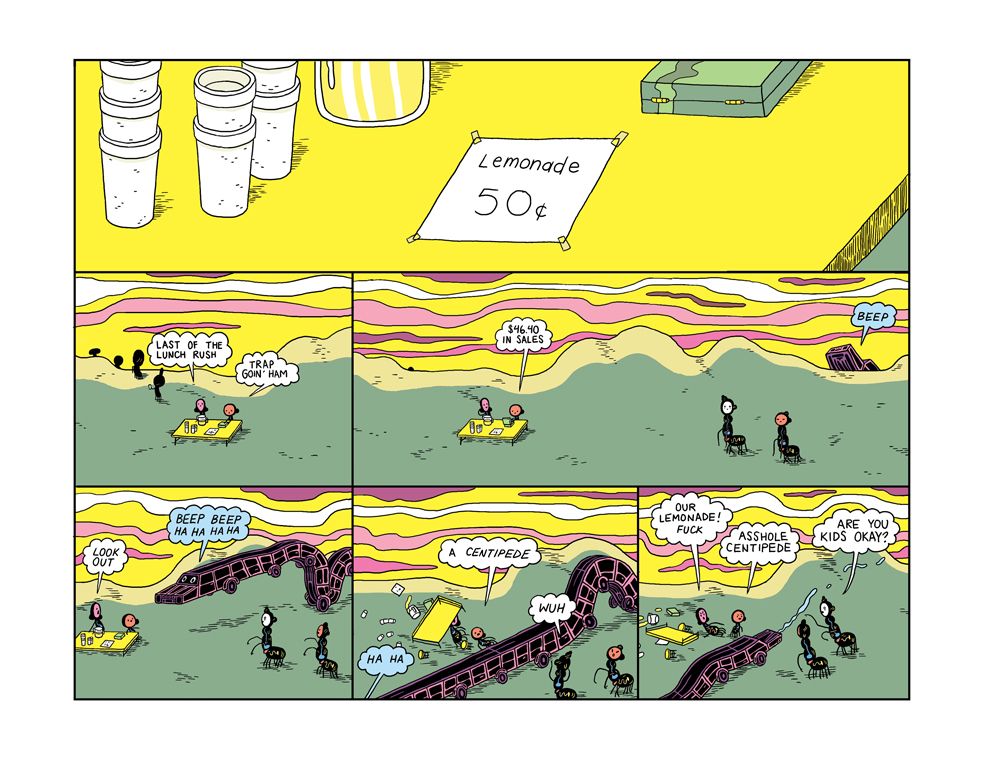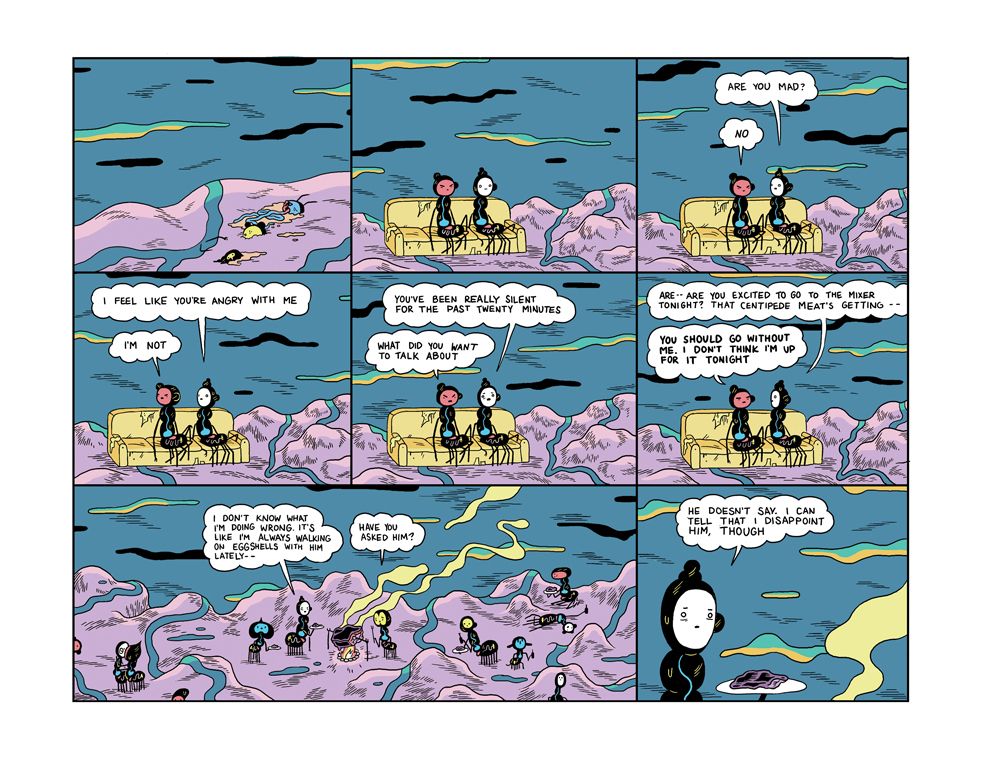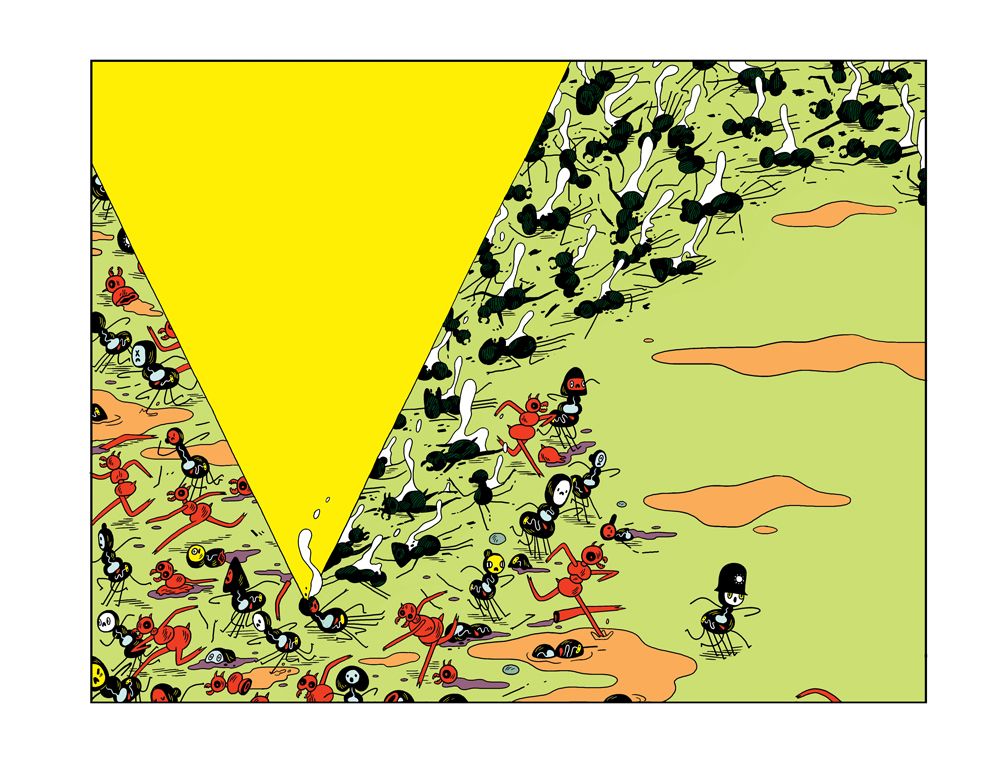Since Michael DeForge burst onto the comics scene a few years ago, the prolific cartoonist has written and drawn hundreds of pages of comics, both online and in print. In the pages of "Lose," "Very Casual" and elsewhere, he's been creating an incredible series of short comics. DeForge received three Ignatz Awards at 2013's SPX for Outstanding Series, Outstanding Anthology, and Outstanding Artist. He also works as a designer on the animated series "Adventure Time."
His new book, which also happens to be his first full-length graphic novel, is "Ant Colony." Hitting stores this week from Drawn and Quarterly, "Ant Colony" was originally published online, a page at a time. The book shows off many of DeForge's talents including, among other things, his great skills at character and creature design.
CBR News: Where did "Ant Colony" start?
Michael DeForge: "Ant Colony" started as a one page color strip in an issue of "Smoke Signal."
At what point did you know that this was going to be a graphic novel as opposed to a short piece?
I intended it to just be a single strip at first, but I liked the idea enough to do two more pages set in that world in "Lose" #3. Then a few months later, I realized I wanted to start an ongoing serial with it. The strips were originally conceived as a bunch of one-off, self-contained installments, but that went out the window very quickly.
"Ant Colony" was published online, one page at a time. How much do you think that affected the shape of it and the pacing?
I'm not sure if it being online affected that stuff too much. When I started it, I was in talks with some college papers and alternative weeklies who were interested in printing it as well, but they all ended up flaking out, so it ended up being exclusively a web thing. I do enjoy the process of serializing my work, though. Most of the comics I draw are released on some sort of schedule, and I think it's become easier for me to think of my stories in small, manageable parts rather than tackling some huge narrative all at once.
When telling these longer stories in short sections, are you thinking of those sections as self-contained or stand-alone pieces or what, exactly?
I still wanted each strip to still hit certain beats and reach a kind of "punchline" by the last panel. Doing it as a serial forced me to think that way -- forcing each page to reach a type of conclusion at the end, rather than letting too much action spill over into the next installment.
When assembling the longer narrative of "Ant Colony," how much did you have planned out in advance? To what degree did you know where the narrative was heading and to what degree were you writing as you went?
I eventually knew that story would have to reach certain key points -- I knew how I wanted it to end, I knew there had to be a war, I knew there was going to be a magnifying glass bit -- but I tried to give myself a lot of space between those points to improvise or take the story down little detours. I write my comics a page at a time, which has been helpful for working on longer narratives. I don't script out my comics out in advance anymore, and thumbnail each page the morning before I start drawing it.
I'm curious about how you design characters. The male ants, the female ants, the other creatures are all so unique. What were you thinking and how did you approach designing these creatures?
A lot of that was really just intuitive. Some things, like drawing a centipede as a long, purple limousine, just seemed funny to me. It's hard to talk about character design because a lot of it is just about some things looking "right" and some things looking "wrong." I sit down in front of a sketchbook and fill pages for a while, and eventually a character's design just starts to make sense.
How integral to your process is sketching? How much do you do that isn't working things out, but just drawing for drawing's sake?
It's very important. I bring my sketchbook everywhere. A lot of my "pencils" for pages are done in my sketchbook. Most of the work I do in my sketchbook isn't done with a specific project in mind, but of course many of my ideas for finished comics have come out of that type of directionless drawing.
You've produced an incredible numbers of comics in recent years, mostly short pieces, and I'm curious; what was different with "Ant Colony?" Was it a very different experience?
It's the longest finished narrative I've done so far, so it was a pretty big change for me. ("Kid Mafia" has more pages, but isn't close to being finished yet). I draw a lot of short stories, partially because I like that medium a lot, but also because I get bored really easily. It's been difficult for me to commit to longer comics, although I think I'm getting better at it.
As you mention, "Kid Mafia" is in process and will be your longest work to date. Did working on "Ant Colony" and being able to complete it and look back on it affect your approach to "Kid Mafia?"
Not so much, only because I always had some sort of end point in mind for "Ant Colony" -- I wasn't sure if I wanted it to be 50 pages or 300 pages at first, but I knew at some point, the comic would wrap. But "Kid Mafia" is something I want to draw for many more years, where the characters grow up and age in real time. There's no end in sight for "Kid Mafia," which makes it a unique thing for me.
Later this year, you have "A Body Beneath" coming out from Koyama. Does that collect all of the work that you've published in "Lose" so far, or just some?
It doesn't collect "Lose" #1, and there are some pages omitted from the other issues because they didn't read very organically when arranged in sequence now that it's in book form.
You're work on webcomics as well as print comics. Do you think of them differently in any way, or do you approach them the same?
I approach them the same. I draw everything with an eventual printed collection in mind, but there aren't print publications where you can serialize comic strips, anymore. Putting things online is just the easiest, cheapest and most efficient way to get work in front of people now.
Outside of your comics work, you're a designer for "Adventure Time." Can you talk a little about what you do and your work on it?
I'm a props and effects designer, but I've done odd bits of storyboard work, character design and concept art. I like my job a lot -- it's the best day job I could have ever asked for.
You're coming off a pretty big 2013. You received three Ignatz Awards including Outstanding Artist at SPX, and there was the publication of "Very Casual," which collected many of your short comics. Now you have your first graphic novel out. I'm curious about how much thought you've given to what you've done and what you want to do, thinking about your career and work, going forward.
I just want to keep working, really. I feel lucky that I've been able to afford to pursue a career in cartooning to the extent that I have, and I just want to keep that going for as long as I can. I know, realistically, that these opportunities might eventually dry up for me and I'll have to go back to warehouse or dishwashing work, so I'm trying to make the best of the time I have now to work as hard as I can on my comics.
Michael DeForge is on tour in the United States and Canada for "Ant Colony" through mid-February. For tour dates and more information, check out D&Q's post, here.





